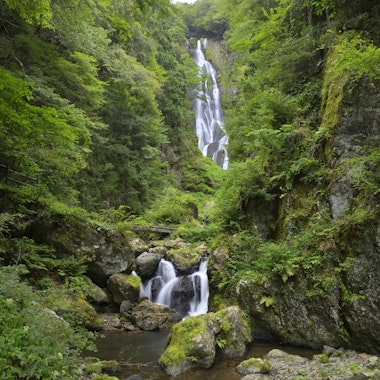


Kanba Falls stands as the largest waterfall in Western Japan, located in Maniwa City, Okayama Prefecture. The waterfall cascades from a height of 110 meters with a width of 20 meters, creating a dramatic display as water plunges down black cliffs in multiple tiers. This natural wonder has earned recognition as one of Japan's Top 100 Waterfalls and has been designated a Place of Scenic Beauty by the national government. The waterfall has also been selected as one of Japan's 100 Landscapes, reflecting its cultural and aesthetic importance within the country's natural heritage.
The surrounding area encompasses a 100-hectare nature park where the valley forests showcase spectacular seasonal changes. Early summer brings lush green foliage, while autumn transforms the landscape with vibrant red and yellow maple leaves. A distinctive feature of Kanba Falls is the protruding black rock formation in its center, locally known as Koiwa or "Carp Stone," named for its resemblance to a carp swimming upstream, a popular motif in Japanese folklore. The park also served as a filming location for the NHK historical drama "Musashi," adding to its cultural significance.
Visitors follow a well-maintained promenade from the parking area, reaching the base of the falls in approximately five to ten minutes. The pathway follows a rocky streambed lined with deciduous trees including maples, zelkovas, and katsuras. Along this trail, the smaller Tamatare Falls (also called Tamasudare or "Hanging Droplet Falls") offers a contrasting experience, with delicate rivulets trickling over moss-covered rock before falling into the stream below. The sound and appearance resemble rain dripping from a thatched roof, giving the cascade its name. For adventurous visitors, a hiking trail leads to Oni-no-ana, or "Demon's Cave," a limestone cave located 260 meters from the ticket office, requiring approximately 30 to 50 minutes for a return trip.
A unique attraction at Kanba Falls is the population of approximately 200 wild Japanese macaques that inhabit the forested area. These monkeys are most frequently spotted between December and March when mountain food supplies are lowest. While they are accustomed to human presence and generally remain calm, visitors should not feed them or carry plastic bags that might be mistaken for food. The macaques are native to Japan and represent the northernmost-living non-human primate species in the world. Lucky visitors may observe mothers with newborns in spring or adults with bright red faces during mating season in autumn.
Access to Kanba Falls requires careful planning. By car, the falls are approximately 30 minutes from either Kuse IC or Yubara IC on the Yonago Expressway via Route 313 and Route 201. Free parking is available with 77 spaces for regular vehicles, 3 for buses, and 6 for motorcycles. Public transportation options include taking the JR Tsuyama Line from Okayama Station to Tsuyama, transferring to the JR Kishin Line to Chūgoku-Katsuyama Station, then taking a taxi to the falls. Alternatively, Maniwa City's Community Bus (Maniwakun) operates 6-7 buses daily from Kuse Station and Chūgoku-Katsuyama Station to Kanba Falls. From the Kanba-Guchi bus stop, it is a 50-minute walk to reach the waterfall.
Admission fees are ¥300 for adults and ¥150 for elementary and junior high school students. The park is closed from December 29 to January 3 for the New Year holiday period. The trail features natural rock steps that can be slippery and requires caution, making the site not wheelchair accessible. Visitors should wear appropriate footwear and be prepared for uneven terrain. The park does not permit pets due to the presence of wild monkeys.